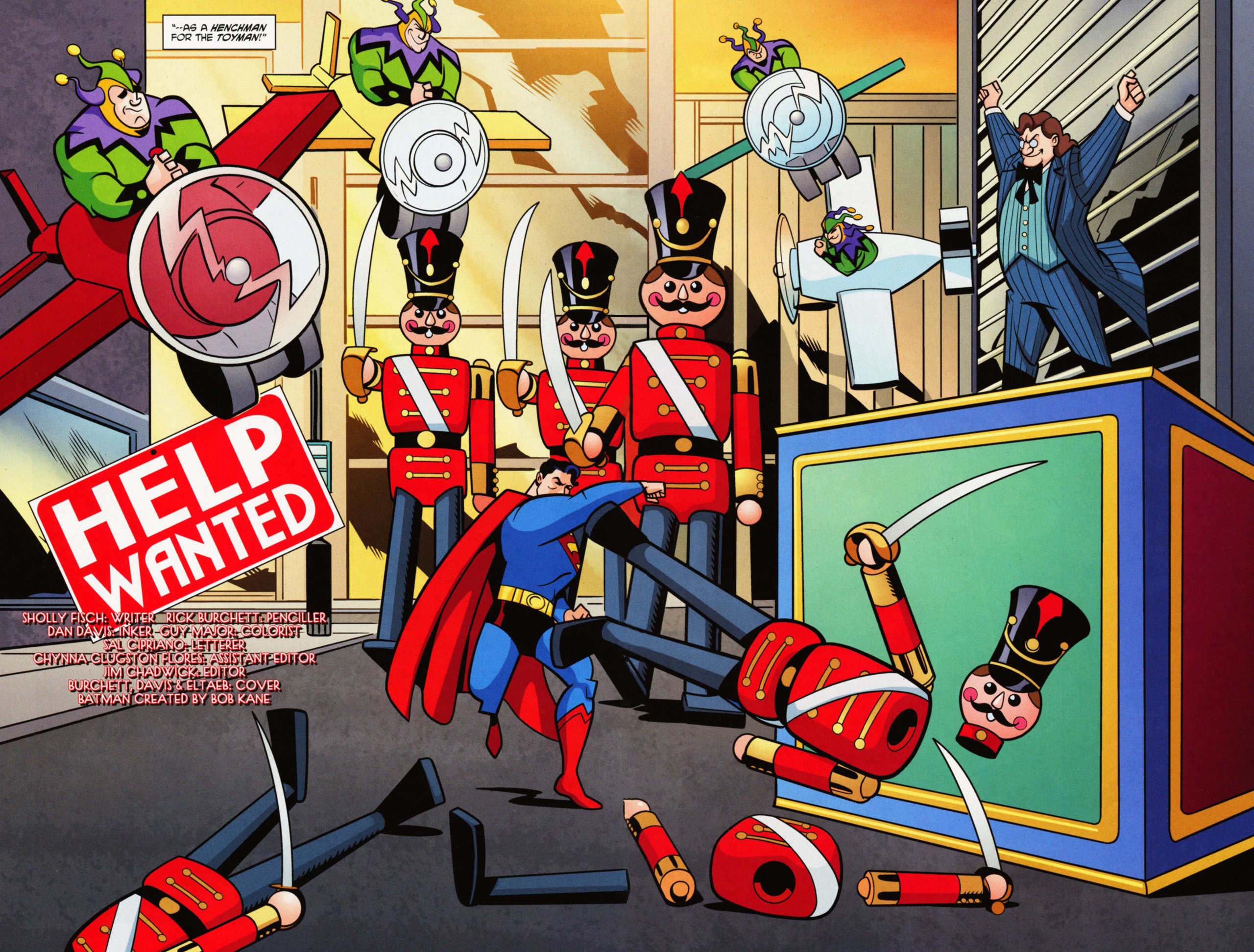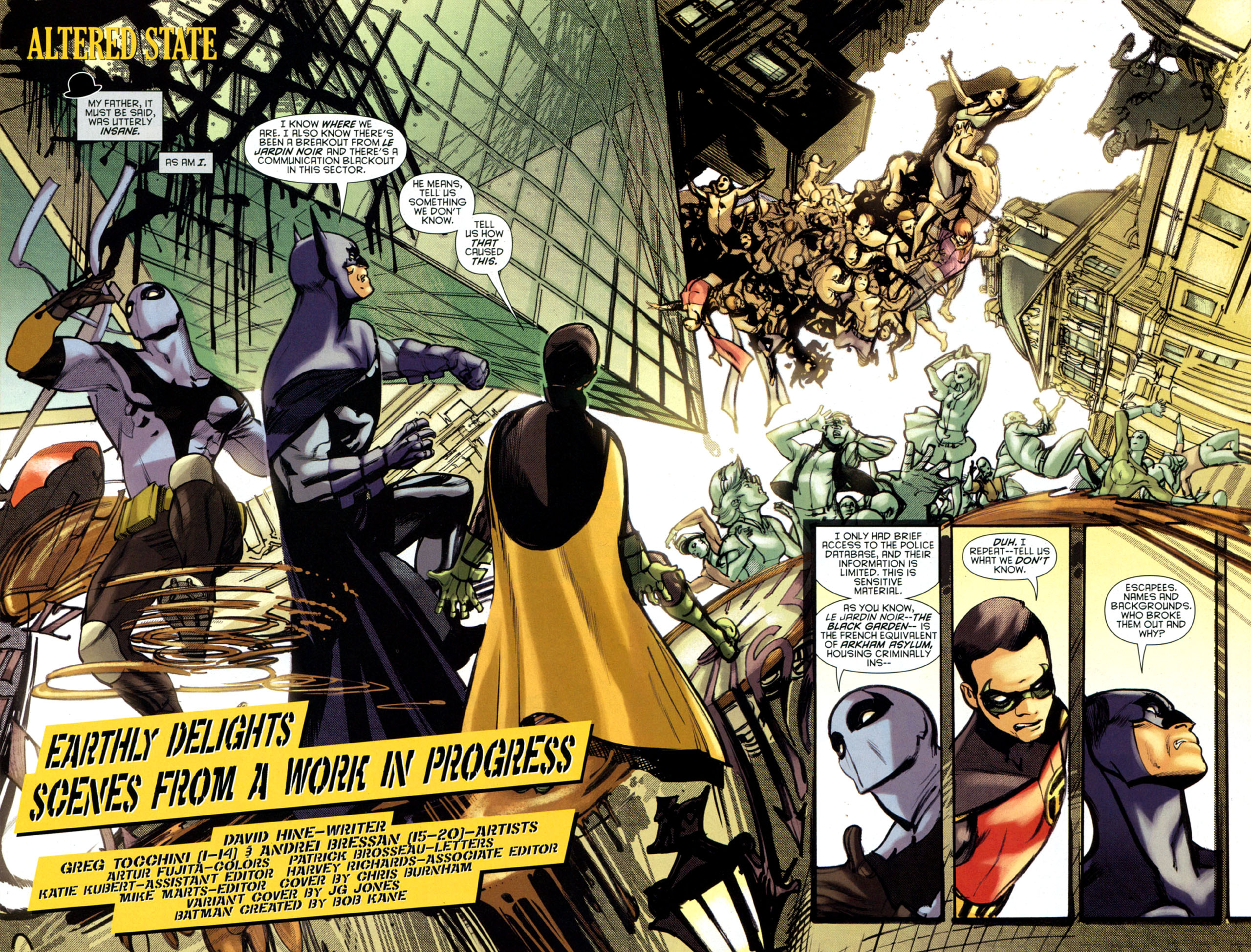If you read the last posts, you know what’s going on. Here are another ten stories that would definitely be included if I had a chance to put together a giant Batman omnibus collecting personal favorites:
- ‘Devil’s Advocate’ (Joker: Devil’s Advocate, cover-dated February 1996), by Chuck Dixon (script), Graham Nolan (pencils), Scott Hanna (inks), Pat Garrahy (colors), John Costanza (letters)
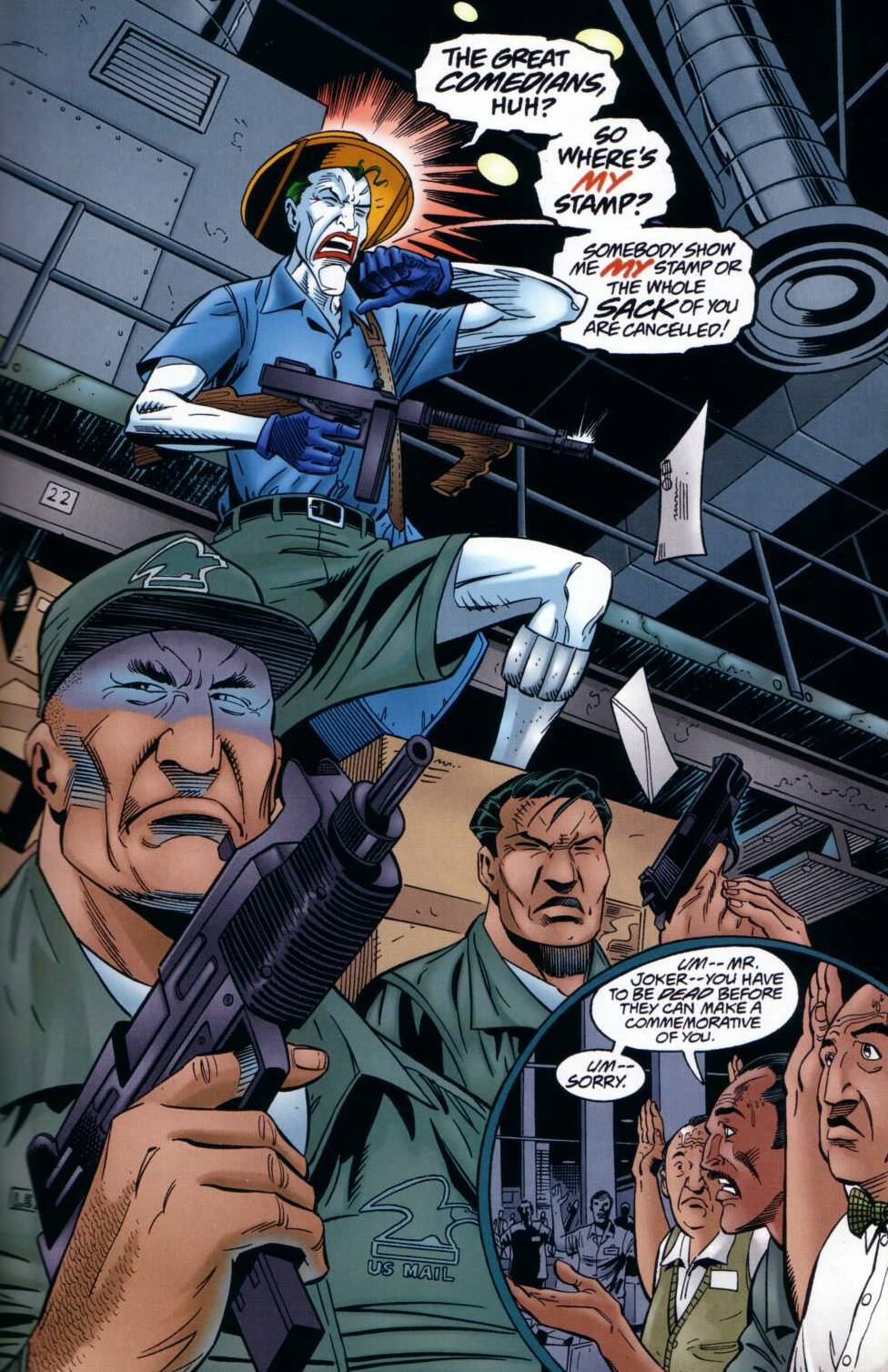
‘Devil’s Advocate’ is a serious – albeit very funny – contender for greatest Joker comic of all time (up there with ‘The Laughing Fish,’ ‘The Killing Joke,’ and ‘Mad Love’). In this one-shot about the Clown Prince of Crime finally standing trial and going to jail with a looming death sentence, Chuck Dixon and Graham Nolan bring together much of the cast of their Detective Comics run, from the detective duo of Harvey Bullock and Renée Montoya to the staff and inmates at Blackgate prison (where we get a priceless gag involving a harmonica), plus a handful of cameos. Also from that run, we get a clear narrative with smooth art and pitch-perfect dialogue (Alfred about Bruce: ‘He’s like all great detectives. He possesses a deep-seated loathing for mysteries.’). Dixon has often gone back to the notion that Batman, more than refusing to kill the Joker, is actually willing to repeatedly go out of his way to save his enemy’s life. That becomes a key point in ‘Devil’s Advocate,’ which (as the title suggests) is all about the discomfort of applying higher ideals of justice even to the benefit of someone hateful, i.e. the kind of moral dilemmas and ends-vs-means tension that shapes Batman’s crusade from the start. This is surely not a unique instance of popular fiction provocatively integrating a topic as complex and grim as capital punishment (the brutal Mission: Impossible episode ‘The Execution’ comes to mind), but it’s impressive how the book does it in such a slapstick and ingeniously plotted way. (93 pages)
- ‘Perpetual Mourning’ (Batman: Black and White #1, cover-dated June 1996), by Ted McKeever (script, art), John Workman (letters)
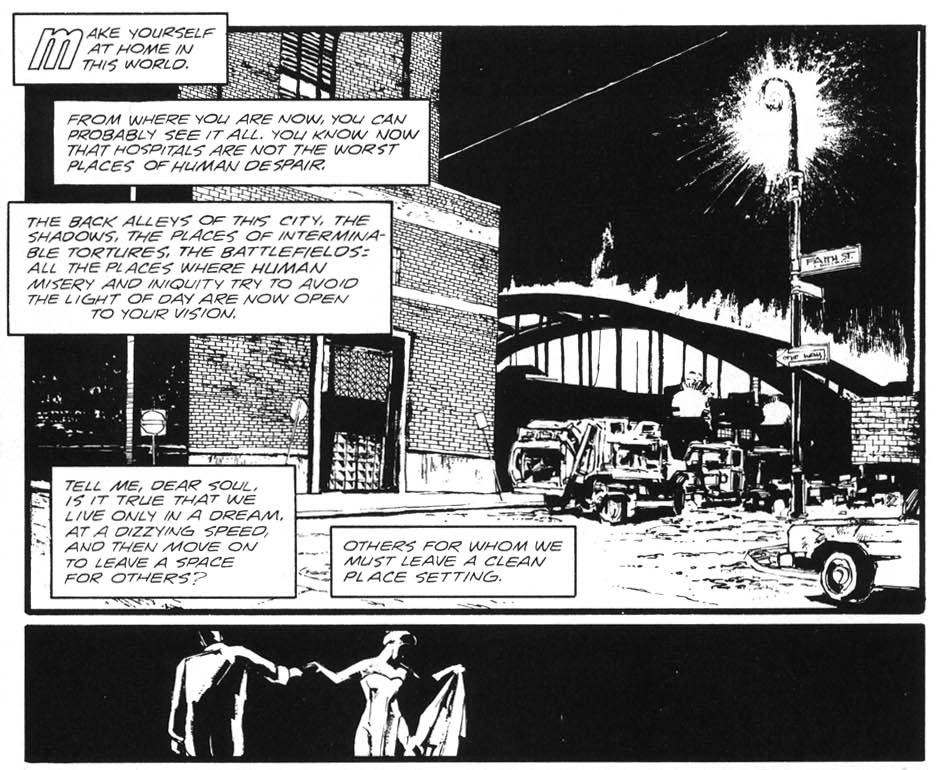
It’s only eight pages, but ‘Perpetual Mourning’ takes readers for what is possibly Batman comics’ most powerful and heartbreaking ride. We follow the Dark Knight as he examines a woman’s corpse and puts together clues about her and her murder. This framing device allows Ted McKeever to not only showcase Batman’s skills as the World’s Greatest Detective, but also highlight his solitary dedication to the pursuit of justice for the victims of violent crime (Warren Ellis and Jim Lee would go on to do a neat variation of this device in the short story ‘To Become the Bat’). That said, the main impact comes from McKeever’s introspective prose over the noirish black & white art, plus the beautiful symbolic interludes with the dancing couple. A masterpiece. (8 pages)
- ‘Devil’s Trumpet’ (Batman: Black and White #1, cover-dated June 1996), by Archie Goodwin (script), José Muñoz (art), Phil Felix (letters)
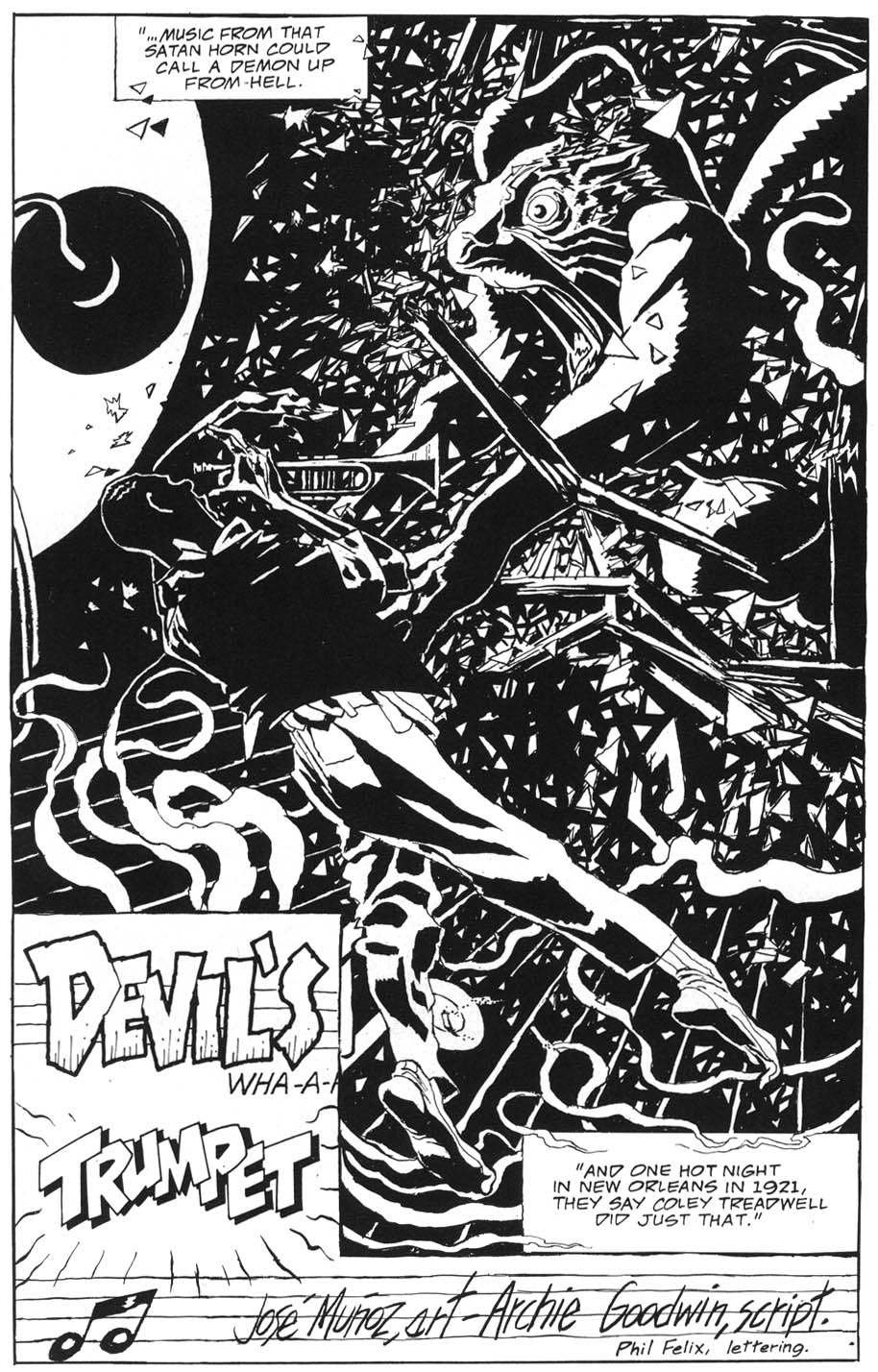 As if ‘Perpetual Mourning’ wasn’t enough, the same issue of the original Batman: Black & White mini-series featured this awesome story by two giants of the medium. José Muñoz’s expressionistic art is even closer to film noir than Ted McKeever’s. Meanwhile, Archie Goodwin’s script, which focuses on a musician desperate to get his hands on a mythical trumpet, feels like a throwback to his work for Warren’s horror anthologies Creepy and Eerie, except that it culminates with the Dark Knight suddenly showing up like a scary avenging angel. I’m just a sucker for these peripheral narratives in which Batman is not the star but a silhouetted force of nature that shapes Gotham City’s urban legends and the lives of petty criminals who get in over their heads… (8 pages)
As if ‘Perpetual Mourning’ wasn’t enough, the same issue of the original Batman: Black & White mini-series featured this awesome story by two giants of the medium. José Muñoz’s expressionistic art is even closer to film noir than Ted McKeever’s. Meanwhile, Archie Goodwin’s script, which focuses on a musician desperate to get his hands on a mythical trumpet, feels like a throwback to his work for Warren’s horror anthologies Creepy and Eerie, except that it culminates with the Dark Knight suddenly showing up like a scary avenging angel. I’m just a sucker for these peripheral narratives in which Batman is not the star but a silhouetted force of nature that shapes Gotham City’s urban legends and the lives of petty criminals who get in over their heads… (8 pages)
- ‘Through the Long Night’ (Batman & Robin Adventures #20, cover-dated July 1997), by Ty Templeton (script), Brandon Kruse (pencils), Terry Beatty (inks), Linda Medley (colors), Tim Harkins (letters)
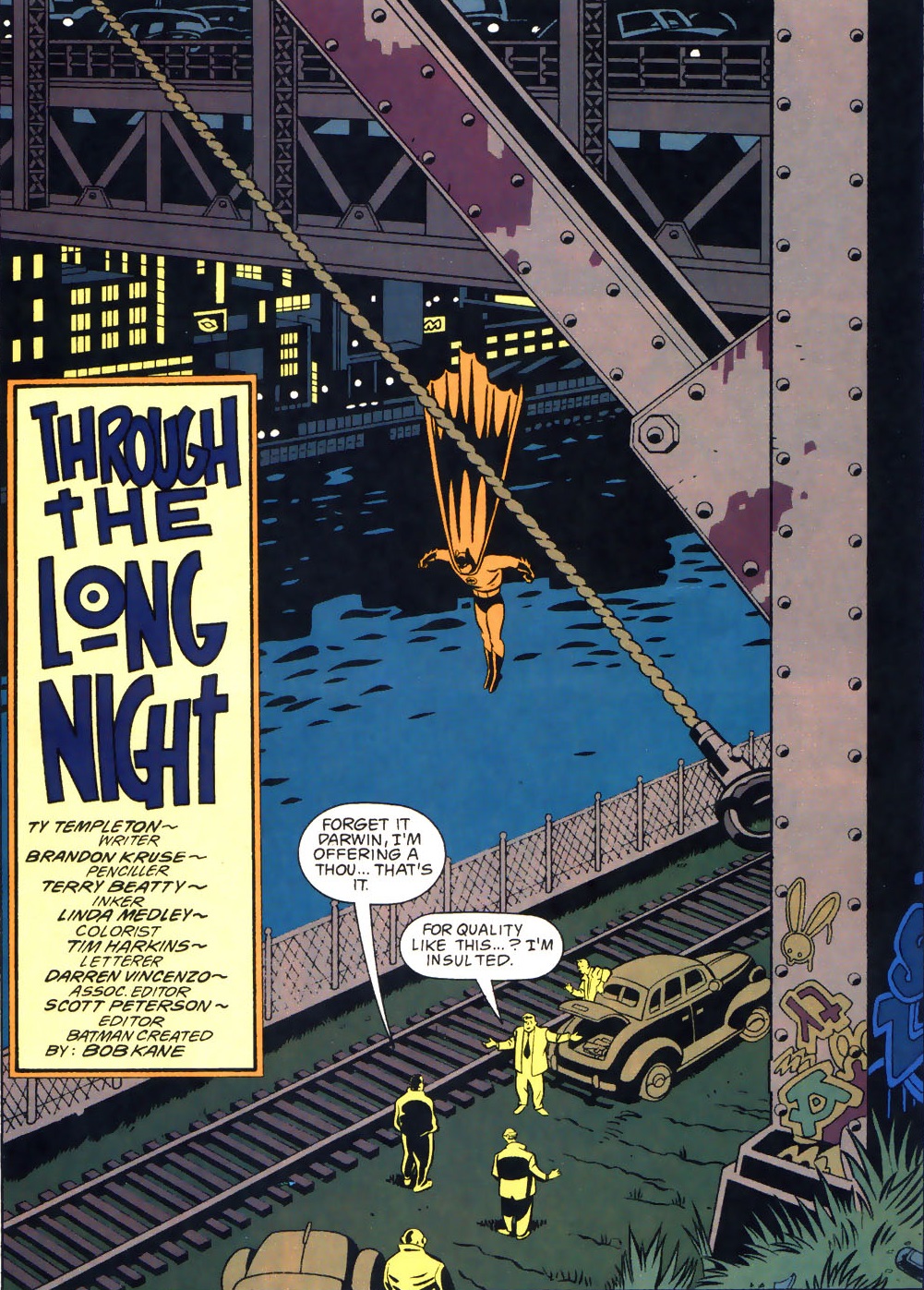
I’m also a huge fan of Ty Templeton’s run in the Adventure books, where he penned a wonderful string of unpretentious, action-packed, and often quite funny self-contained tales. His Batman and Robin were a swell, heroic team who hated guns and saved the day by outwitting their adversaries, which is not to say that they didn’t kick plenty of butts along the way. ‘Through the Long Night’ does one of my favorite tricks, which is to imagine how a place like Gotham would actually work – if you think about it, of course the local cops would regularly bet on how many crooks the Dynamic Duo could catch before the end of the night shift (and of course there’d be a street gang called ‘The Vampires’). Moreover, true to character, while the Caped Crusader and the Teen Wonder relentlessly fought one group of criminals after another (plus an angry dog), of course police detective Harvey Bullock would keep trying to improve his odds. Sure, the premise is simple, but the execution makes this a real treat. (22 pages)
- ‘Claws’ (Gotham Adventures #4, cover-dated September 1998), by Ty Templeton (script), Rick Burchett (pencils), Terry Beatty (inks), Lee Loughridge, Zylonol (colors), Tim Harkins (letters)
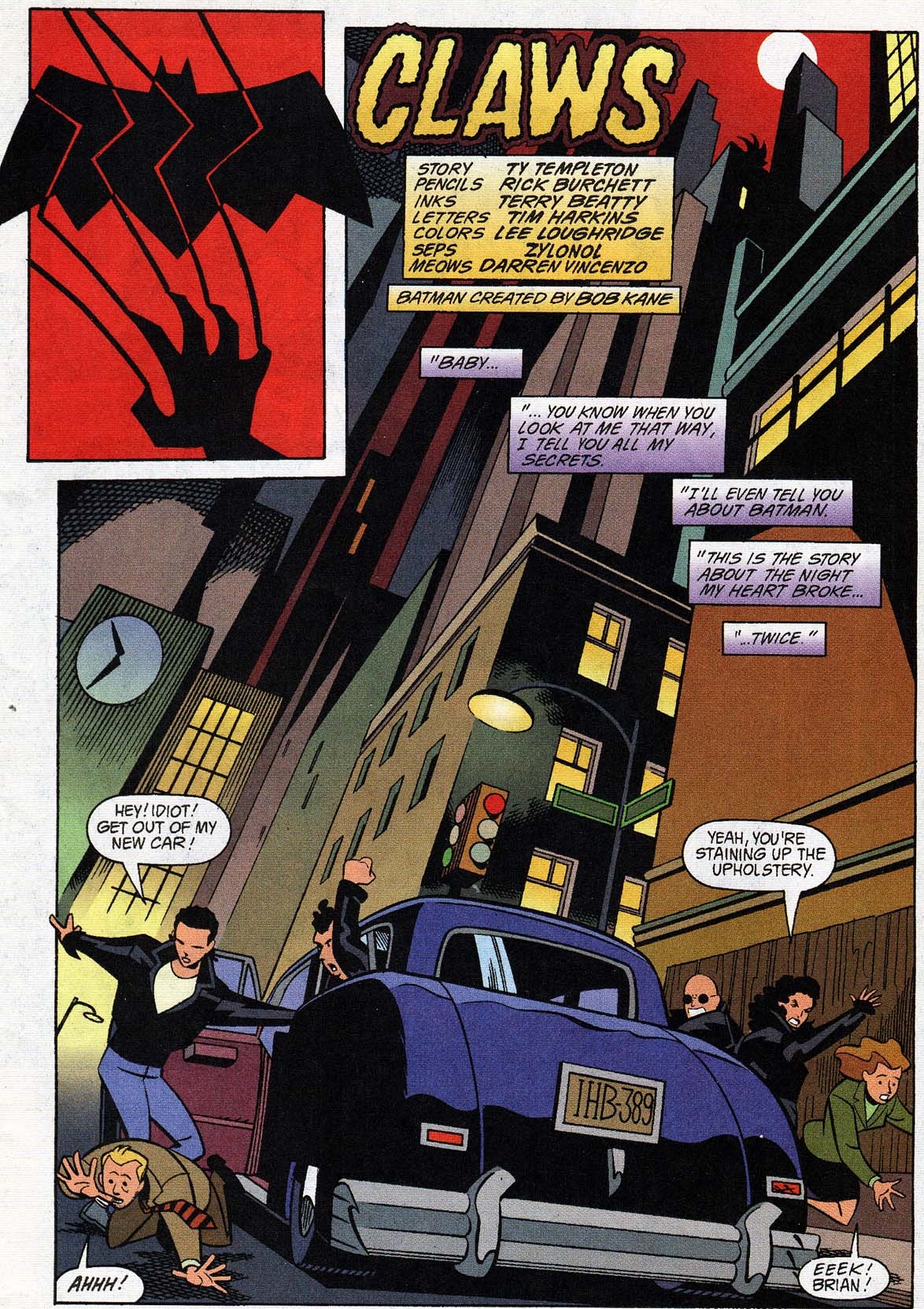 Another Templeton-written gem, with even niftier visuals thanks to Rick Burchett’s stylishly angular pencils. Last time I wrote about it, this is what I had to say: ‘Selina [Kyle]’s obsession with cats has spurred quite a few anti-vivisection stories throughout the years. You can argue that escapist superhero comics may not be a suited forum for such a topic (in contrast to, say, Scottish anarcho-punk), but this tale from Gotham Adventures pulls it off, because the story isn’t just preachy, it’s faithful to the character. It’s also a great example of Batman’s and Catwoman’s flirty yet doomed relationship, as their morals keep getting in the way of their romance.’ (22 pages)
Another Templeton-written gem, with even niftier visuals thanks to Rick Burchett’s stylishly angular pencils. Last time I wrote about it, this is what I had to say: ‘Selina [Kyle]’s obsession with cats has spurred quite a few anti-vivisection stories throughout the years. You can argue that escapist superhero comics may not be a suited forum for such a topic (in contrast to, say, Scottish anarcho-punk), but this tale from Gotham Adventures pulls it off, because the story isn’t just preachy, it’s faithful to the character. It’s also a great example of Batman’s and Catwoman’s flirty yet doomed relationship, as their morals keep getting in the way of their romance.’ (22 pages)
- ‘The Hill’ (The Hill, cover-dated May 2000), by Christopher Priest (script), Shawn Martinbrough (pencils), John Lowe, Shawn Martinbrough (inks), Ben Dimagmaliw (colors), John Costanza (letters)
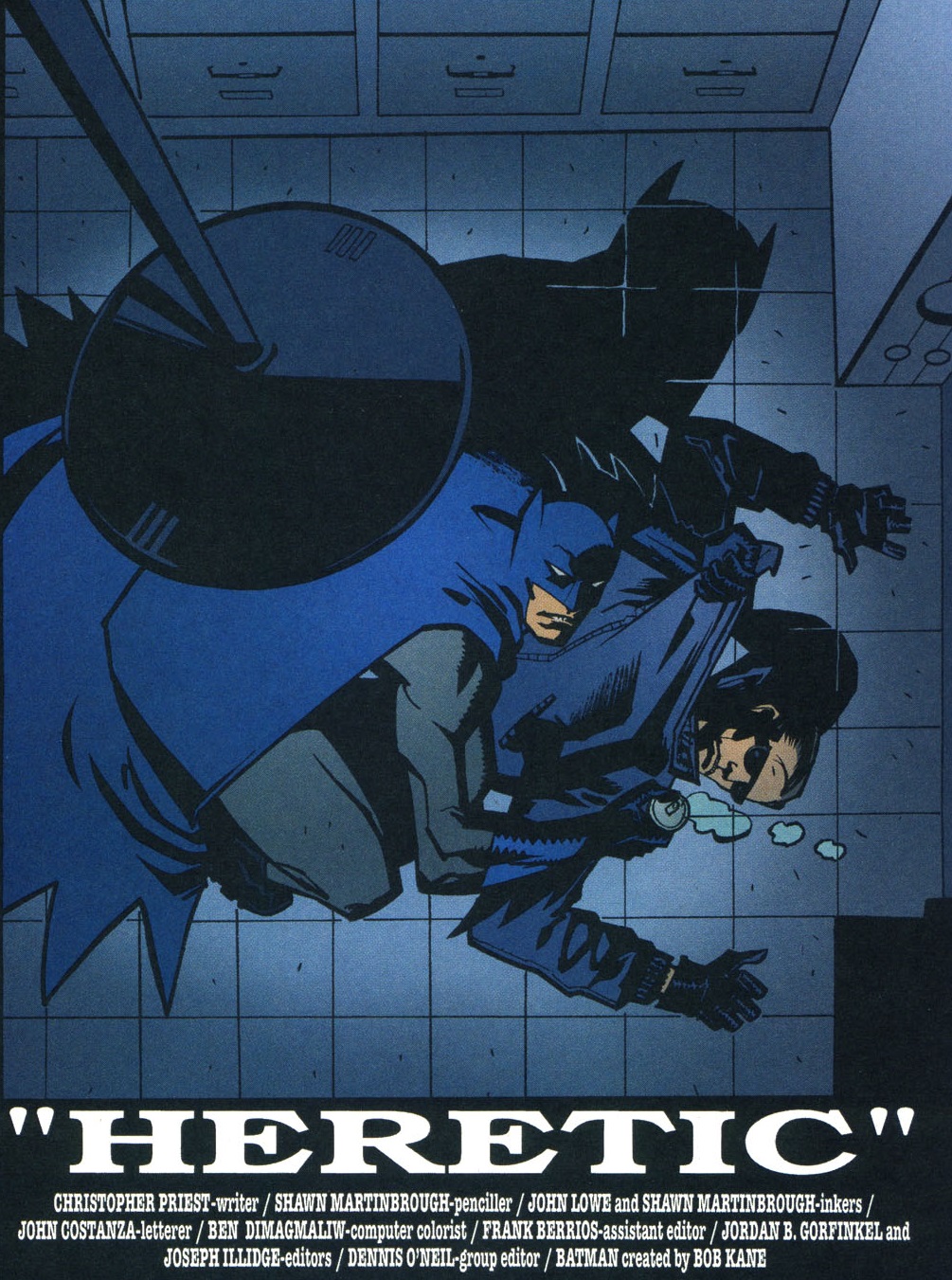 An underappreciated one-shot about Batman facing the limits of his impact (and, by extension, the limits of the superhero archetype he embodies) as well as, more broadly, America’s failure to grasp and respond to the trials of its poorer communities. I’ve written about this one as well: ‘As hard as it is to write Batman stories informed by social realism, Christopher Priest pulls it off with confidence in this crime tale set in the Hill, Gotham City’s ghetto for the disenfranchised African-American community. Basically, the Dark Knight goes after a local kingpin but has to face the fact that people in the Hill are exposed to so much drama and violence in their everyday lives that they hardly give a damn about some white guy in a cape. Artists Shawn Martinbrough and John Lowe help keep the comic tight, with a cinematic flow, although the narrative could have benefited from some decompression – it would have been more powerful and easy to follow if the various characters had been given more room to breathe. Regardless, Priest delivers pre-The Wire dialogue rich with urban slang and deals with the topic of social exclusion in a way that may be superficial but doesn’t come across as insultingly naïve or annoyingly preachy. Even better, he gives us a Bruce Wayne for whom both the Batman disguise and his douchebag playboy persona are means to an end, and who is willing to fully reinvent himself in order to achieve his aims.’ (39 pages)
An underappreciated one-shot about Batman facing the limits of his impact (and, by extension, the limits of the superhero archetype he embodies) as well as, more broadly, America’s failure to grasp and respond to the trials of its poorer communities. I’ve written about this one as well: ‘As hard as it is to write Batman stories informed by social realism, Christopher Priest pulls it off with confidence in this crime tale set in the Hill, Gotham City’s ghetto for the disenfranchised African-American community. Basically, the Dark Knight goes after a local kingpin but has to face the fact that people in the Hill are exposed to so much drama and violence in their everyday lives that they hardly give a damn about some white guy in a cape. Artists Shawn Martinbrough and John Lowe help keep the comic tight, with a cinematic flow, although the narrative could have benefited from some decompression – it would have been more powerful and easy to follow if the various characters had been given more room to breathe. Regardless, Priest delivers pre-The Wire dialogue rich with urban slang and deals with the topic of social exclusion in a way that may be superficial but doesn’t come across as insultingly naïve or annoyingly preachy. Even better, he gives us a Bruce Wayne for whom both the Batman disguise and his douchebag playboy persona are means to an end, and who is willing to fully reinvent himself in order to achieve his aims.’ (39 pages)
- ‘Deathtrap A-Go-Go!’ (Batman Adventures (v2) #9, cover-dated February 2004), by Gabe Soria (script), Dean Haspiel (art), Zylonol (colors), Nick J. Napolitano (letters)
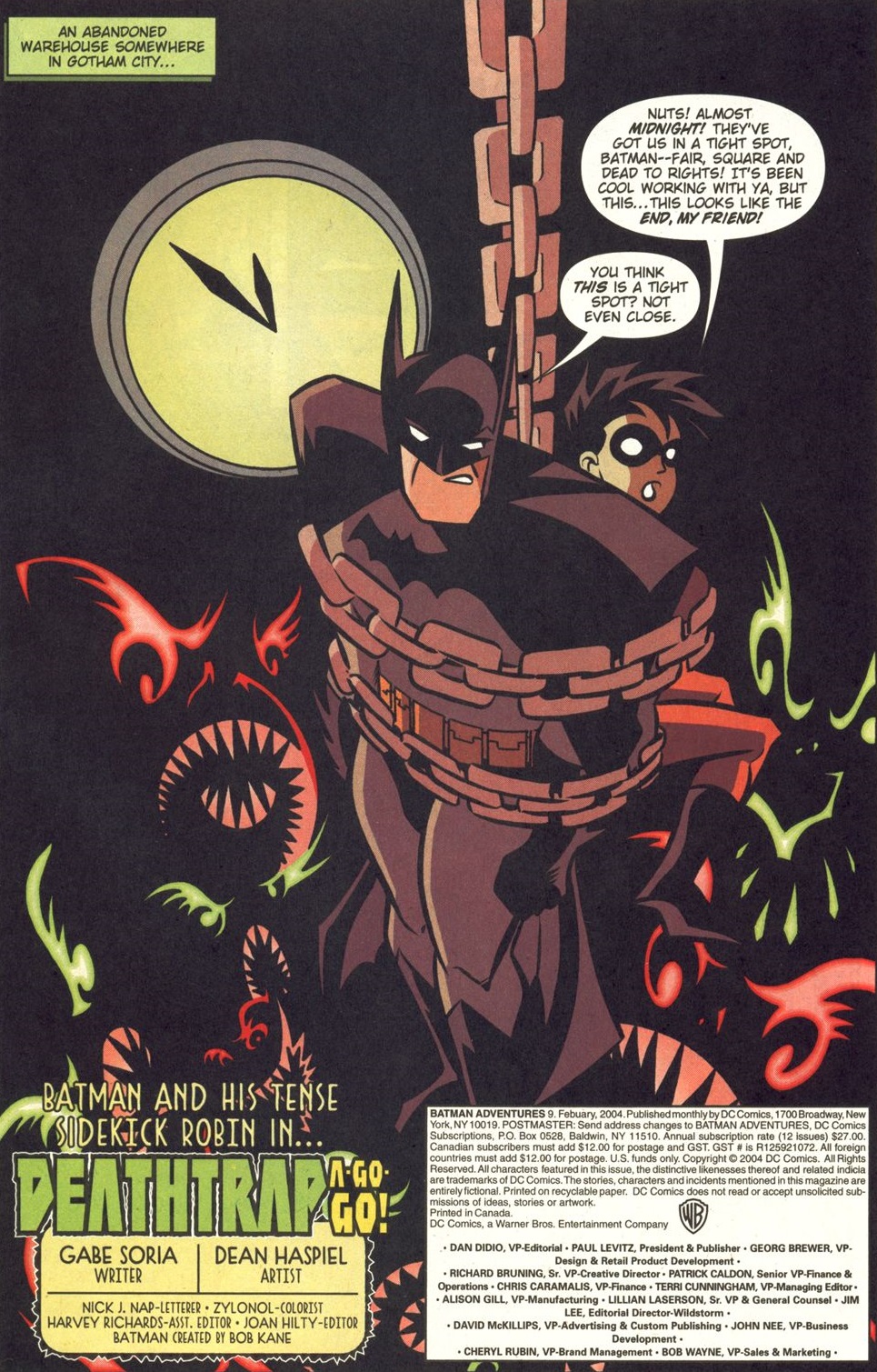
From the blog’s archive: ‘In an abandoned warehouse somewhere in Gotham, the Dynamic Duo, surrounded by monsters and caught in a deathtrap with time ticking away until their supposed demise (or as Batman might as well call it, just another night), discuss the very concept of ‘deathtrap.’ What the comic lacks in plot, it more than makes up for in hilarious gags and one-liners. Less a metafictional satire of a ridiculous trope than a celebration of its imaginative potential, there are enough ideas in these 17 pages to fill in a 2-year run by today’s pacing standards.’ Of particular note is the amazing splash page with the Scarecrow’s boobytrapped House of Horrors, where each division works as a comic panel, so that we can simultaneously see the Caped Crusader wrestle a tentacled creature on the first floor and decapitate a zombie at the ground level. (17 pages)
- ‘Dead Robin’ (Gotham Central #33-36, cover-dated September-December 2005), by Ed Brubaker, Greg Rucka (script), Kano (pencils), Stefano Gaudiano (inks), Lee Loughridge (colors), Clem Robins (letters)
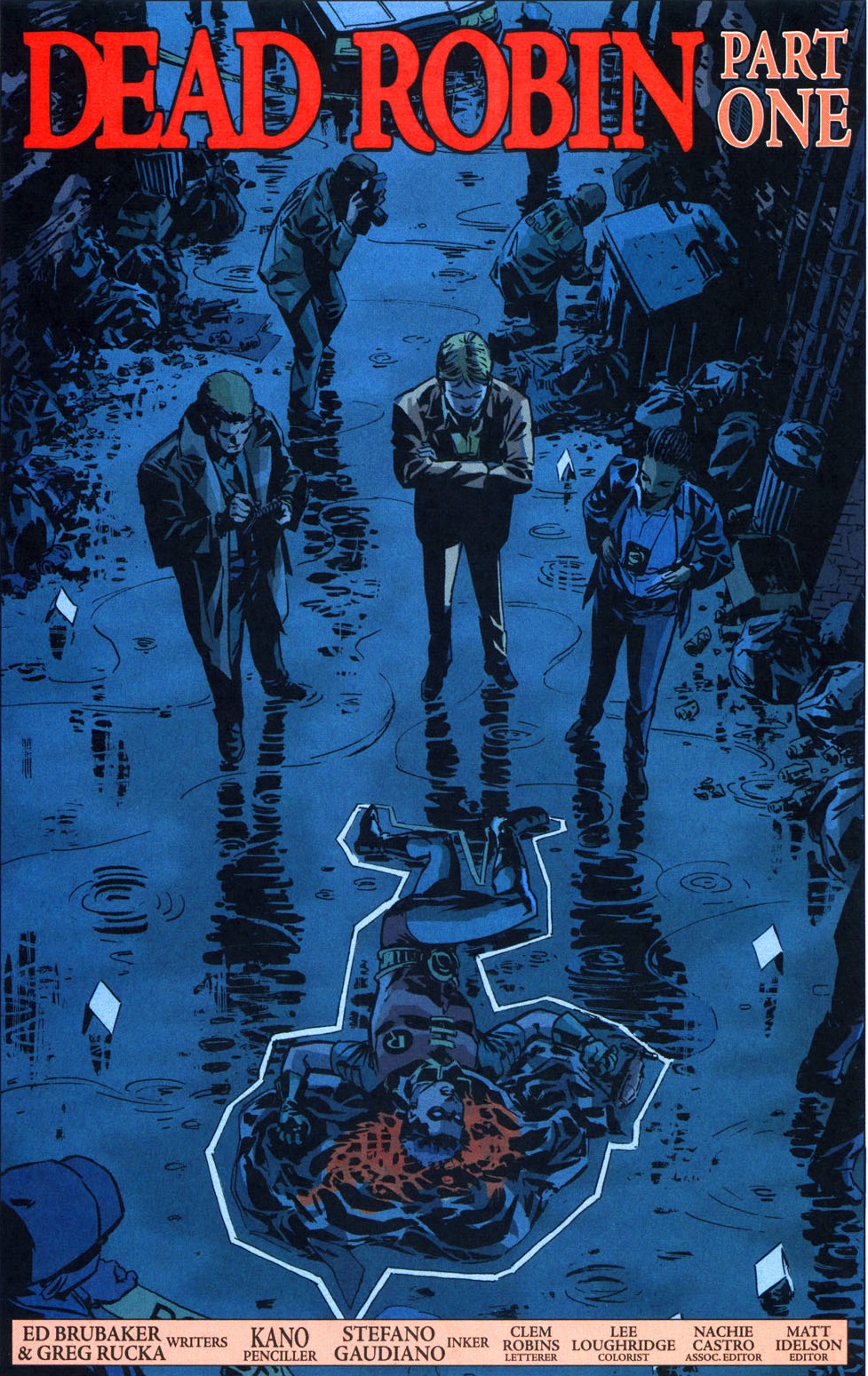
Going back to the realist end of the spectrum, Gotham Central explored Batman’s hometown through the eyes of the Major Crimes Unit. One of the finest police procedurals ever, this comic has it all: nuanced characterization, moody art, and credible, adult storytelling about what it’s like to be a detective in a city where, every time you kick down a door, you may come across a mad killer armed with a freezing ray. Gotham Central’s greatest story arc is arguably ‘Dead Robin,’ a four-parter that kicks off with a corpse who may or may not be the Boy Wonder. Greg Rucka and Ed Brubaker (two of the medium’s most talented crime writers) get a lot of mileage out of the police’s limited perspective – the protagonists aren’t even sure if there is more than one Robin around and they rightfully suspect Batman is conducting his own parallel investigation just beyond their sight (like when they arrive at Arkham, only to find most inmates suffering from recent injuries…). When the Dark Knight does show up, it feels suitably shocking and terrifying. There are callbacks to previous arcs and character development (references to Corrigan’s corruption, Chandler’s grudge against Batman) as well as a subtext about Batman’s trauma over the death of his previous sidekick, Jason Todd, but ‘Dead Robin’ stands well on its own as a rounded mystery full of cool scenes. (88 pages)
- ‘Help Wanted’ (Batman: The Brave and the Bold (v2) #10, cover-dated October 2011), by Sholly Fish (script), Rick Burchett (pencils), Dan Davis (inks), Guy Major (colors), Sal Cipriano (letters)
With its cartoony designs and superhero-heavy team-ups, the 21st century iteration of The Brave and the Bold couldn’t be more distant from Gotham Central – like its precursor, the series thrives on boisterous escapades in which the Caped Crusader faces deliriously fantastic threats with the same practical, straight-faced attitude he deals with Gotham’s street-level crime (the same spirit that informs this year’s weird animated romp Batman Ninja, in which the Dark Knight hardly blinks after being thrown into the middle of mecha battles in feudal Japan). Yet this is not an awkward transition, as this issue also allows us to see Batman through someone else’s perspective, which – as you’ve probably gathered by now – is something that really appeals to me. Besides the Eisneresque gesture of treating the masked hero as a supporting character in the lives of ordinary people, it’s just refreshing to get a closer look at the quirky world around what is usually the main action. Told from the point of view of a professional henchman, ‘Help Wanted’ is a great example of how you can tell this kind of story and still finish on a poignant note about the Caped Crusader himself. Plus, despite the upbeat, all-ages-friendly tone, I cannot help but sense a mild satire about how today’s precarious job market encourages us to pursue increasingly risky, immoral gigs for ruthless employers… (20 pages)
- ‘Earthly Delights, Scenes from a Work in Progress’ (Batman and Robin #26, cover-dated October 2011), by David Hine (script), Greg Tocchini, Andrei Bressan (art), Artur Fujita (colors), Pat Brosseau (letters)
Let’s finish with a reminder of Batman comics’ rich history of blending a supposedly unsophisticated genre with nods to more respected culture and formal experimentation, this one from the prolific Dick-Grayson-as-Batman era. It’s another issue I’ve written about before and I’ll definitely revisit it in the future: ‘The Dynamic Duo gets called in by Nightrunner (AKA the French Dark Knight) when there is a breakout at the Parisian version of Arkham Asylum. What ensues is a surreal battle among an upside-down Louvre and an insane mob whose collective id has been magically unleashed. The twist is that, because it’s France, the villains are all mind-bending and highbrow, their crimes channeling various arts, such as film, architecture, sculpture, painting, performance, and literature. Writer David Hine planned for a longer storyline but ended up getting only one issue, so he crammed all his fascinating ideas into 20 pages of madness. Hine, who is a master craftsman of bizarre, conceptual comics (if you don’t believe me, check out his Bulletproof Coffin), breaks the issue into sub-sections paying homage to specific creators, from René Magritte to Man Ray. The result is fun, challenging, and sometimes mesmerizing. No wonder Hine decided to open the comic with the word ‘Dada.’’ All in all, it’s a dazzling piece of work, with Greg Tocchini’s and Andrei Bressan’s art, Artur Fujita’s colors, and the letters of Pat Brosseau (as Patrick Brosseau) more than living up to Hine’s idiosyncratic script. (20 pages)
Total page number from all these comics: 914. Add to that some of the covers, plus a thought-provoking intro by Mark Waid, and you’d have one hell of a volume!

